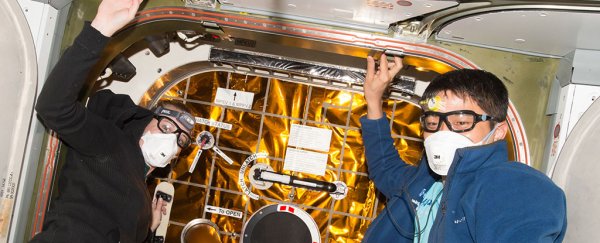The International Space Station (ISS) is usually a pretty clean place. But where there are people, there are microorganisms.
And when you're trapped in a giant hunk of metal some 400 kilometres (250 miles) above the surface of Earth, you really want to know what that furry white stuff is growing in the corner.
Right now, the only way to test contaminants of the space station is to collect samples and send them down to the planet.
"We have had contamination in parts of the station where fungi was seen growing or biomaterial has been pulled out of a clogged waterline, but we have no idea what it is until the sample gets back down to the lab," says NASA microbiologist Sarah Wallace.
Normally it's not such a big deal for astronauts, who have a ready supply of disinfectants on hand, but we'd want to be able to do those tests right there in space, especially once future missions move beyond the safe cocoon of Earth's relative proximity.
"As we move beyond low-Earth orbit where the ability for resupply is less frequent, knowing what to disinfect or not becomes very important," says Wallace.
That's why NASA has been working on a new project, Genes in Space-3. Its goal is to establish a user-friendly system for astronauts to sequence DNA of various microorganisms aboard the ISS.
"The Genes in Space-3 experiments demonstrate ways in which portable, real-time DNA sequencing can be used to assay microbial ecology, diagnose infectious diseases and monitor crew health aboard the ISS," explains the project website.
Just last year, molecular biologist and astronaut Kate Rubins was the first person to ever sequence DNA in space. She used a small device called MinION, which relies on nanopore technology to analyse DNA and RNA in real time.
Devices such as MinION are routinely used in the field to track the spread of diseases like Ebola and Zika, or studying environmental samples in places like Antarctica.
But before Rubins successfully used MinION on the ISS, nobody was sure if it would work in microgravity. For the test, investigators sent up ready-made samples of mouse, viral, and bacterial DNA, and then compared Rubins's results against tests done on the same samples back on Earth.
If we're ever going to evade superbugs and detect aliens, what we really want is the ability to identify unknown organisms right there in space. And to do that, we need technology to prepare those samples.
Fortunately, NASA also has a device called miniPCR. It was designed by 17-year-old student Anna-Sophia Boguraev for the inaugural Genes in Space competition.
Boguraev's invention is a handy, ISS-friendly version of a device needed to perform polymerase chain reaction (PCR) on a DNA sample so that it can be analysed.
 Anna-Sophia Boguraev with miniPCR. Credit: NASA
Anna-Sophia Boguraev with miniPCR. Credit: NASA
By joining the two technologies, NASA now has a workable solution to prepare, sequence, and identify microorganisms from start to finish right there on the space station.
"What the coupling of these different devices is doing is allowing us to take the lab to the samples, instead of us having to bring the samples to the lab," says NASA biochemist Aaron Burton.
This is good news for all future astronauts, as it will be extremely useful if there's ever something weird growing on the walls of the space station.
"Onboard sequencing makes it possible for the crew to know what is in their environment at any time," Wallace, who is the project's chief investigator, said last year. "That allows us on the ground to take appropriate action – do we need to clean this up right away, or will taking antibiotics help or not?"
Besides, ISS is basically a giant space laboratory, and adding these molecular biology tools to its arsenal will help with many other experiments aboard. And it's possible that one day we'll be taking these tools to Mars and beyond.
Who knows if we'll be sequencing alien life any time soon (come on, Enceladus), but at least when we stumble across it, we'll come prepared.
